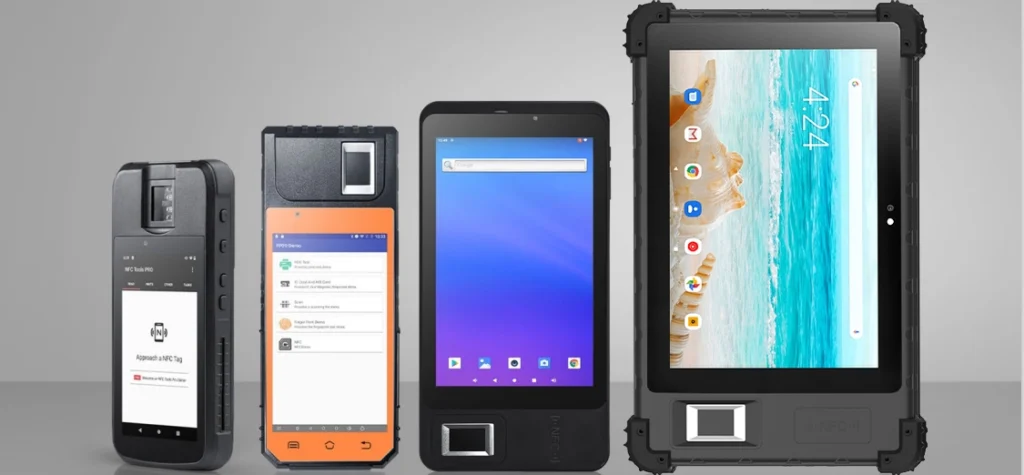指紋スキャナーの製造業者はますます増えていますが、信頼できる指紋スキャナー工場を選択することは、製品の品質とサービスの信頼性を確保する上で非常に重要です。
指紋スキャナーは、セキュリティ分野で広く使用されている生体認証技術デバイスです。アクセス制御、出席、支払いなどで重要な役割を果たします。適切な指紋スキャナー工場を選択するのに役立つ重要な要素をいくつか紹介します。
指紋スキャナ技術は、その比類のないセキュリティ、利便性、精度により、さまざまな業界でますます重要になっています。その重要性について簡単に説明します。
- セキュリティ: 指紋スキャナは、非常に安全な認証およびアクセス制御の方法を提供します。指紋は各人の固有のものであるため、複製や偽造は事実上不可能であり、銀行、医療、政府などの業界でセキュリティ対策を強化します。
- 利便性: 指紋スキャナーは、従来のキー、カード、パスワードを必要とせずに、ユーザーがデバイス、システム、または施設にアクセスするための便利で効率的な方法を提供します。これにより、認証プロセスが簡素化され、従業員と顧客の両方の時間が節約されます。
- 精度: 指紋スキャナーは個人の識別において高い精度を提供し、不正アクセスや個人情報の盗難のリスクを軽減します。この精度は、機密情報や立ち入り禁止区域を保護する必要がある業界では非常に重要です。
- コンプライアンス: 指紋スキャナー テクノロジーは、組織がデータ保護、プライバシー、セキュリティに関連する業界の規制や標準に準拠するのに役立ちます。金融、医療、法執行機関などの多くの分野では規制の厳格な遵守が求められており、指紋スキャナーはコンプライアンスに不可欠なツールとなっています。
- 効率: 指紋スキャナーは、認証手順を自動化し、手動入力エラーを排除することで、プロセスとワークフローを合理化します。これにより、スピードと精度が重要な業界での運用効率と生産性が向上します。
- 統合: 指紋スキャナ技術は、勤怠管理、アクセス制御システム、顧客データベースなどの既存のシステムとシームレスに統合できます。この相互運用性により、セキュリティの強化と業務の合理化を目指すさまざまな業界にとって、多目的なソリューションとなります。
結論として、指紋スキャナ技術は、幅広い業界でセキュリティ、利便性、精度、コンプライアンス、効率、統合を強化する上で重要な役割を果たします。組織が資産、データ、人員を保護するために堅牢な認証方法を優先するにつれて、指紋スキャナ技術の採用は増え続けています。

指紋スキャナメーカーを選ぶためのヒント
ニーズを調査して理解する:
指紋スキャナーを実装するためのビジネスまたはプロジェクトの特定の要件を検討する際には、選択したテクノロジーがニーズを効果的に満たすことを確認するために、いくつかの重要な要素を評価することが重要です。考慮すべき事項は次のとおりです。
セキュリティニーズ:
- ビジネスやプロジェクトに必要なセキュリティ レベルを決定します。機密領域やデータを保護するための基本的な認証方法、またはより高度なアクセス制御ソリューションをお探しですか?
- 保護されている情報または資産の機密性と、不正アクセスに関連する潜在的なリスクを考慮してください。
- 暗号化、なりすまし防止機能、改ざん検出など、指紋スキャナーが提供するセキュリティ機能を評価し、セキュリティ要件に適合していることを確認します。
スケーラビリティと統合:
生体認証指紋スキャナ メーカーのソリューションの拡張性を評価することは、ビジネスやプロジェクトの現在および将来のニーズに対応できることを確認するために重要です。指紋スキャナ ソリューションの拡張性を評価するための重要な考慮事項は次のとおりです。
ユーザー容量:
- 指紋スキャナ ソリューションがサポートできるユーザー数を決定します。組織またはユーザー ベースの現在の規模を考慮し、将来の成長を予測して、システムが時間の経過とともに増加するユーザー数に対応できるようにします。
- パフォーマンスやセキュリティを損なうことなく、システム内で登録、保存、認証できるユーザーの最大数に関して、指紋スキャナーのスケーラビリティを評価します。
場所とアクセスポイント:
- 将来、指紋スキャナ システムを追加の場所、施設、またはアクセス ポイントに拡張する必要があるかどうかを評価します。システムを複数のサイトまたは遠隔地に対応するように簡単に拡張できることを検討します。
- さまざまなネットワーク構成、インフラストラクチャ設定、接続オプションと指紋スキャナー ソリューションの互換性を評価し、さまざまな場所間でのシームレスな統合を実現します。
他のシステムとの統合:
- 指紋スキャナー メーカーのソリューションが、業務運営に必要となる可能性のある他のシステム、ソフトウェア、またはサードパーティ アプリケーションと統合できるかどうかを検討します。既存または将来のテクノロジと接続するためのシステムの互換性と柔軟性を評価します。
- アクセス制御システム、勤怠管理ソフトウェア、訪問者管理ソリューション、または機能強化のために統合する必要がある可能性のあるその他のセキュリティ アプリケーションとの相互運用性の観点から、指紋スキャナーのスケーラビリティを評価します。
パフォーマンスとスループット:
- 認証速度、応答時間、スループット レートの観点から、指紋スキャナー ソリューションのパフォーマンス機能を評価します。システムの拡張に伴って増加するユーザー トラフィックやトランザクション量をシステムが処理できるかどうかを判断します。
- 処理能力、メモリ容量、ネットワーク帯域幅などの要素を考慮して、指紋スキャナーがボトルネックや速度低下を経験することなく、需要の高い状況でも最適なパフォーマンス レベルを維持できるようにします。
アップグレードおよび拡張オプション:
- 指紋スキャナ ソリューションで利用可能なアップグレードおよび拡張オプションについて問い合わせます。進化する要件を満たすために、追加の機能、モジュール、またはライセンスを使用してシステムを簡単にアップグレードできるかどうかを判断します。
- ベンダーの製品開発と将来の機能強化のロードマップを評価し、ニーズの拡大に応じて指紋スキャナー ソリューションが継続的にサポートされ、新しい機能と性能で更新されることを確認します。
現在および将来のニーズに対応できるように指紋スキャナ ソリューションの拡張性を評価することで、ビジネスまたはプロジェクトに対するテクノロジの適合性について十分な情報に基づいた決定を下すことができます。システムが効果的に拡張可能で、ユーザー容量の増加、場所の追加、および統合要件をサポートできることを保証することで、指紋スキャナ ソリューションの長期的な価値とパフォーマンスを最大化できます。
ビジネス環境における既存のシステム、ソフトウェア、ハードウェアと指紋スキャナの互換性を検討する際には、スムーズな実装プロセスのためにスキャナが IT インフラストラクチャとシームレスに統合できることを確認することが重要です。指紋スキャナの互換性を評価するための重要な考慮事項は次のとおりです。
オペレーティング システムの互換性:
指紋スキャナーが、Windows、macOS、Linux、または Android や iOS などのモバイル プラットフォームなど、組織で使用されているオペレーティング システム (OS) と互換性があるかどうかを確認します。
シームレスな操作を実現するために、指紋スキャナー ドライバー、ソフトウェア開発キット (SDK)、およびアプリケーションが、コンピューター、サーバー、またはモバイル デバイスにインストールされている OS バージョンでサポートされていることを確認してください。
アプリケーション統合:
アクセス制御システム、勤怠管理ソフトウェア、ID 管理プラットフォームなど、生体認証を必要とする既存のソフトウェア アプリケーションまたはシステムと指紋スキャナーの互換性を評価します。
指紋スキャナーが、データ交換と相互運用性のためにサードパーティのアプリケーション、データベース、または Web サービスと統合できる一般的な認証プロトコル、API、またはインターフェースをサポートしていることを確認します。
ハードウェアインターフェースの互換性:
既存のハードウェア インフラストラクチャ、ネットワーク設定、周辺機器との互換性を確保するには、USB、イーサネット、Bluetooth、Wi-Fi 接続など、指紋スキャナーでサポートされているハードウェア インターフェイス オプションを確認します。
ビジネス環境で従業員、顧客、訪問者が使用するデスクトップ コンピューター、ラップトップ、タブレット、スマートフォン、その他のデバイスに指紋スキャナーを簡単に接続できるかどうかを評価します。
スケーラビリティと柔軟性:
組織内のさまざまな場所や部門にわたる複数のデバイス、ユーザー、またはアクセス ポイントをサポートするという観点から、指紋スキャナー ソリューションの拡張性と柔軟性を考慮してください。
ビジネス環境の多様なニーズを満たすために、指紋スキャナーをスタンドアロン デバイス、ネットワーク システム、クラウド ベースのサービスなどのさまざまな構成で展開できるかどうかを評価します。
セキュリティとコンプライアンス:
指紋スキャナー ソリューションが、GDPR、HIPAA、FIDO 標準などのデータ セキュリティ、プライバシー、生体認証に関する業界標準、規制、ベスト プラクティスに準拠していることを確認します。
指紋スキャナーが、暗号化、安全な送信プロトコル、改ざん検出、ユーザー認証メカニズムなどの強力なセキュリティ機能を提供し、機密性の高い生体認証データを保護し、IT インフラストラクチャとの安全な統合を確実にすることを確認します。
ビジネス環境内の既存のシステム、ソフトウェア、ハードウェアと指紋スキャナーの互換性を慎重に評価することで、スムーズな実装プロセスと IT インフラストラクチャとのシームレスな統合を実現できます。テクノロジー エコシステム、アプリケーション要件、セキュリティ標準に適合する指紋スキャナーを選択すると、組織内の運用効率とデータ保護を維持しながら、生体認証の利点を活用できます。
ユーザーエクスペリエンスと使いやすさ:
指紋スキャナーのユーザー エクスペリエンスを評価することは、ビジネス環境の従業員、顧客、訪問者にとって直感的で使いやすく、使いやすいものであることを確認するために不可欠です。指紋スキャナーのユーザー エクスペリエンスを評価する際に考慮すべき重要な要素は次のとおりです。
登録手順:
- ユーザーの指紋をシステムに登録する容易さを評価します。登録プロセスが簡単で直感的、かつユーザーフレンドリーであり、セットアップ中にユーザーに明確な指示とガイダンスが提供されることを確認します。
- 指紋テンプレートのキャプチャと保存の効率、正確な登録に必要なサンプルの数、ユーザーがスキャン時に指を正しく配置するのに役立つフィードバック メカニズムを考慮してください。
認証プロセス:
- ユーザーが安全なエリア、デバイス、またはアプリケーションにアクセスしようとしたときの指紋認証プロセスの速度と精度を評価します。スキャナーが遅延やエラーを引き起こすことなく、ユーザーの身元を迅速かつ確実に確認できることを確認します。
- スキャンの成功または失敗を示す視覚的または聴覚的な合図など、認証プロセス中に提供されるユーザー フィードバックを評価して、ユーザーが認証試行の結果を簡単に理解できるようにします。
ユーザーインターフェースとフィードバック:
- 認証プロセスを通じてユーザーをガイドするために使用されるディスプレイ画面、ボタン、インジケーター、プロンプトなど、指紋スキャナー インターフェイスの設計とレイアウトを確認します。
- ユーザー インターフェイスが直感的で、視覚的に魅力的で、操作が簡単であること、スキャンまたは認証プロセスの各ステップでユーザーに明確な指示とフィードバックが提供されることを確認します。
アクセシビリティと人間工学:
- 特に身体能力、障害、または人間工学的な好みが異なるユーザーのために、指紋スキャナーのアクセシビリティと人間工学を考慮してください。
- 指紋スキャナー デバイスのサイズ、形状、配置、指紋センサーの位置などの要素を評価して、ビジネス環境のさまざまなユーザーが快適に使用できることを確認します。
トレーニングとサポート:
- 指紋スキャナーを効果的に使用する方法と、認証プロセス中に発生する可能性のある一般的な問題やエラーのトラブルシューティング方法について、ユーザーに適切なトレーニングとサポートを提供します。
- ユーザーが日常業務で指紋スキャナーを使用するための機能やベストプラクティスを理解できるように、ユーザードキュメント、オンライン リソース、またはヘルプデスク サポートを提供します。
指紋スキャナ メーカーのユーザー エクスペリエンスを登録、認証、ユーザー インターフェイス、アクセシビリティ、サポートの観点から評価することで、テクノロジが直感的で使いやすく、ビジネス環境の従業員、顧客、訪問者にとって使いやすいものになっていることを確認できます。指紋スキャナで肯定的なユーザー エクスペリエンスを実現することで、ユーザーの採用、満足度、セキュリティ対策の遵守が向上し、最終的には生体認証ソリューションの全体的な有効性と成功が向上します。
企業や組織向けの指紋スキャナーを選択する際には、ユーザー層や環境の特定のニーズや好みを考慮することが重要です。タッチレスまたは非接触認証などの便利な機能を備えた指紋スキャナーを選択すると、ユーザー エクスペリエンスが向上し、特定の設定でのセキュリティが向上します。タッチレスまたは非接触認証機能を備えた指紋スキャナーを選択する際に考慮すべき要素は次のとおりです。
- ユーザー層:
- 年齢、身体能力、テクノロジーに対する快適度など、ユーザーの人口統計を評価して、環境に最も適した認証方法を決定します。
- 幼児、高齢者、障害者など、特定のユーザー層にとって、タッチレス認証または非接触認証のどちらがより便利で、衛生的で、使いやすいかを検討してください。
- 衛生と安全:
- 医療施設、研究所、食品加工工場など、衛生と安全が最優先される環境では、デバイスとの物理的な接触を最小限に抑えるために、タッチレスまたは非接触の指紋認証を実装することを検討してください。
- 抗菌コーティング、簡単に清掃できる表面、タッチレス認証オプションなどの衛生的な機能を備えた指紋スキャナーを選択して、汚染のリスクを軽減し、ユーザーにとって安全で健康的な環境を促進します。
- 交通量の多いエリア:
- オフィスビル、小売店、交通ハブなどの交通量の多いエリアでは、タッチレスまたは非接触認証により、認証プロセスを効率化し、アクセス ポイントの混雑を軽減できます。
- 近接センサー、ジェスチャー認識、顔認識などの高速で信頼性の高いタッチレス認証機能を備えた指紋スキャナーを選択して、忙しい環境でもシームレスで効率的なユーザー エクスペリエンスを実現します。
- ユーザーの利便性:
- 忙しいスケジュールのユーザー、手で物を持ち運ぶユーザー、または安全なエリアに素早くアクセスする必要があるユーザーのために、タッチレスまたは非接触の指紋認証の利便性と使いやすさを検討してください。
- ユーザー層の多様なニーズや好みに対応するために、非接触、非接触、従来の指紋スキャンなどの柔軟な認証オプションを提供する指紋スキャナーを選択してください。
- 将来性:
- 選択してください 指紋スキャナー タッチレスまたは非接触認証などの高度なテクノロジーと機能を備えており、投資の将来性を確保し、生体認証セキュリティの新たなトレンドを先取りします。
- 指紋スキャナーが既存のアクセス制御システム、ソフトウェア統合、セキュリティ プロトコルと互換性があることを確認し、現在の環境へのシームレスな導入と統合を容易にします。
タッチレスまたは非接触認証などの便利な機能を備えた指紋スキャナーを選択すると、ユーザー層や環境の特定のニーズを満たし、ビジネスや組織の全体的なユーザー エクスペリエンスを向上させることができます。タッチレスまたは非接触認証機能を備えた指紋スキャナーを選択するときは、ユーザーの利便性、衛生、安全性、人通りの多い場所、将来性などの要素を優先して、セキュリティ要件とユーザーの好みに一致するようにしてください。
コンプライアンスと規制:
指紋スキャナや生体認証ソリューションを実装する際には、ビジネスやプロジェクトがデータ保護や認証方法に関連する業界固有の規制、標準、プライバシー要件の対象になっているかどうかを判断することが重要です。これらの規制に従わないと、法的措置、罰金、評判の低下につながる可能性があります。データ保護や認証方法に関連する業界固有の規制やプライバシー要件を評価して対処するための手順を次に示します。
- コンプライアンス評価を実施する:
- まず、ビジネスやプロジェクトに適用される業界固有の規制、標準、プライバシー要件を徹底的に確認します。これには、データ保護法、業界標準、生体認証データ、認証方法、セキュリティ慣行に関連するガイドラインなどが含まれます。
- GDPR (一般データ保護規則)、HIPAA (医療保険の携行性と責任に関する法律)、PCI DSS (ペイメントカード業界データセキュリティ基準)、NIST (アメリカ国立標準技術研究所) など、業界のデータ保護、プライバシー、認証標準を監督する主要な規制機関、当局、または組織を特定します。
- 生体認証データ保護を評価する:
- 指紋テンプレートや生体認証識別子など、指紋スキャナーによって収集および保存される生体認証データの機密性と分類を評価し、適用される規制や標準で必要な保護レベルを決定します。
- 業界固有の要件に準拠して、生体認証データを不正アクセス、開示、または悪用から保護するために、データ保護対策、暗号化プロトコル、アクセス制御、および安全なストレージ慣行を実装します。
- 認証方法を確認する:
- 指紋照合アルゴリズム、テンプレート保存メカニズム、認証プロトコルなど、指紋スキャナーで使用される認証方法のセキュリティとプライバシーへの影響を評価し、業界固有の規制や標準に準拠していることを確認します。
- 指紋スキャナーが採用する認証方法が、関連する業界のガイドラインやベスト プラクティスに記載されているセキュリティ要件、ユーザビリティ標準、プライバシー原則を満たしていることを確認します。
- プライバシー制御を実装する:
- 業界固有の規制とプライバシー要件に従って、指紋スキャナーを通じて取得された生体認証データの収集、処理、および保存についてユーザーに通知するためのプライバシー管理、同意メカニズム、開示慣行、および透明性対策を確立します。
- ユーザーに、生体認証のオプトインまたはオプトアウト、同意の取り消し、または適用される法律や規制に基づくデータ保護とプライバシーに関する権利の行使を行うオプションを提供します。
- 法律上のアドバイスを求める:
- データ保護、プライバシー、生体認証を専門とする法律の専門家、データ保護担当者、コンプライアンス専門家に相談して、ビジネスまたはプロジェクトが認証方法とデータ保護に関連する業界固有の規制、標準、プライバシー要件に準拠していることを確認してください。
- データ保護と認証の実践に関連する法的、財務的、または評判上のリスクを軽減するために、リスク評価、コンプライアンス監査、規制提出、データ侵害対応計画、および業界固有の規制への非準拠の法的影響に関するガイダンスを求めます。
コンプライアンス評価を実施し、生体認証データ保護を評価し、認証方法を確認し、プライバシー管理を実装し、法的助言を求めることで、ビジネスまたはプロジェクトがデータ保護と認証方法に関連する業界固有の規制、標準、またはプライバシー要件の対象になっているかどうかを判断できます。指紋スキャナ メーカーまたは生体認証ソリューションを実装する際に、規制コンプライアンスとプライバシーの問題に積極的に対処することで、ユーザーとの信頼関係を構築し、機密データを保護し、業界のデータ保護と認証の慣行に関連する法的リスクを軽減できます。
企業や組織向けの指紋スキャナーを選択する際には、選択したデバイスがデータ保護、プライバシー、セキュリティに関連する関連法、規制、ガイドラインに準拠していることを確認することが重要です。GDPR (一般データ保護規則)、HIPAA (医療保険の携行性と責任に関する法律)、PCI DSS (ペイメント カード業界データ セキュリティ標準) などの規制に準拠することは、潜在的な法的または規制上の問題を回避するために不可欠です。選択した指紋スキャナーが関連法とガイドラインに準拠していることを確認するための手順は次のとおりです。
- データ保護法を確認する:
- 欧州連合の GDPR、医療業界の HIPAA、決済カードのデータ セキュリティに関する PCI DSS など、企業や組織に適用されるデータ保護に関する法律や規制をよく理解しておいてください。
- 指紋スキャナーを通じて取得された生体認証データの収集、処理、保存、共有に関連するデータ保護法に概説されている主要な原則、要件、義務を理解します。
- コンプライアンス要件を評価する:
- 認証目的での指紋スキャナーの使用に関連して、GDPR のデータ保護原則、HIPAA のセキュリティ保護手段、PCI DSS の暗号化プロトコルなど、関連する法律やガイドラインに指定されているコンプライアンス要件、セキュリティ標準、プライバシー原則を評価します。
- 選択した指紋スキャナーの製造元が、データ保護法および業界固有の規制に定められた技術的、組織的、法的要件を満たし、関連ガイドラインに準拠しているかどうかを確認します。
- ベンダーのコンプライアンスを確認する:
- 指紋スキャナーのベンダーまたは製造元に、GDPR コンプライアンス認証、HIPAA コンプライアンス ステートメント、PCI DSS コンプライアンス レポートなど、データ保護法、セキュリティ標準、プライバシー規制へのコンプライアンスに関する情報とドキュメントを要求します。
- 指紋スキャナーベンダーが業界のベストプラクティス、データ保護ガイドライン、セキュリティプロトコルに準拠し、生体認証データを保護し、ユーザーのプライバシーを確保し、関連法の遵守違反に関連する法的リスクを軽減していることを確認します。
- プライバシー制御を実装する:
- 適用される法律とガイドラインに従って、指紋スキャナーによって収集および処理される生体認証データを保護するために、プライバシー管理、同意メカニズム、データ保護ポリシー、およびセキュリティ対策を実装します。
- 生体認証データの収集、保存、使用の目的、範囲、影響についてユーザーに通知し、関連する規制に基づいてデータ保護とプライバシーに関する権利を行使するオプションを提供します。
- 定期的な監査を実施する:
- 関連する法律やガイドラインへの準拠を監視および維持するために、指紋スキャナー システム、データ処理活動、プライバシー慣行の定期的な監査、セキュリティ評価、コンプライアンス レビュー、リスク評価を実施します。
- 企業や組織における指紋スキャナーや認証方法の使用に影響を与える可能性のある、データ保護法、セキュリティ規制、業界標準の更新、変更、修正について最新情報を入手してください。
データ保護法を確認し、コンプライアンス要件を評価し、ベンダーのコンプライアンスを検証し、プライバシー管理を実装し、定期的な監査を実施することで、選択した指紋スキャナーが GDPR、HIPAA、PCI DSS などの関連法やガイドラインに準拠していることを保証し、潜在的な法的または規制上の問題を回避できます。指紋スキャナーを実装する際に、データ保護、プライバシー コンプライアンス、セキュリティのベスト プラクティスを優先すると、機密情報を保護し、ユーザーの信頼を築き、関連法やガイドラインに準拠しないことに関連する法的リスクを軽減するのに役立ちます。
指紋スキャナーの製造元がデータ セキュリティとプライバシーに関するベスト プラクティスに従っているかどうかを確認するには、次の点を確認します。
- 暗号化: 製造元は、指紋スキャナーによって収集されたデータを保護するために強力な暗号化方法を使用する必要があります。これには、転送中のデータと保存中のデータの両方の暗号化が含まれます。
- アクセス制御: 製造元は、指紋スキャナーによって収集されたデータにアクセスできるユーザーを制限するために、厳格なアクセス制御を実施する必要があります。これには、ロールベースのアクセス制御と多要素認証の実装が含まれます。
- データ保持ポリシー: 製造元は、データが必要な期間のみ保存され、不要になったら安全に削除されるように、明確なデータ保持ポリシーを策定する必要があります。
- 規制への準拠: 製造元は、指紋スキャナーによって収集されるデータの種類に応じて、GDPR、HIPAA、PCI DSS などの業界規制に準拠する必要があります。
- セキュリティ監査と評価: 製造元は、システム内の脆弱性を特定して対処するために、定期的にセキュリティ監査と評価を実施する必要があります。
- プライバシー ポリシー: 製造元は、指紋スキャナーによって収集されたユーザー データをどのように収集、使用、保護するかを説明する、明確で透明性のあるプライバシー ポリシーを用意する必要があります。
製造元のドキュメント、認証、セキュリティ プラクティスを確認することで、データ セキュリティとプライバシーに関するベスト プラクティスに従ってユーザー情報を保護し、業界の規制への準拠を維持していることを確認できます。
予算と総所有コスト:
ビジネスやプロジェクトに指紋スキャナーを選択する際には、予算の制約を考慮し、総所有コストを評価することが重要です。考慮すべき要素は次のとおりです。
- 初期費用: 市場で入手可能なさまざまな指紋スキャナーの価格を比較します。価格の高いスキャナーは、より高度な機能と優れたセキュリティを備えている場合があることに注意してください。ただし、それらの追加機能が特定の使用例に必要かどうかも考慮する必要があります。
- 継続的なメンテナンス費用: 指紋スキャナーを長期にわたって維持するために必要なコストを検討してください。これには、ソフトウェアの更新、ライセンス料、必要になる可能性のある修理や交換などが含まれます。総所有コストを計算する際には、これらの継続的な費用を考慮することが重要です。
- 総所有コスト: テクノロジーの寿命全体にわたる総所有コストを計算します。これには、初期費用と継続的なメンテナンス費用だけでなく、従業員のトレーニング、既存のシステムとの統合、将来のニーズに対応する潜在的な拡張性などの追加コストも含まれます。
- 投資収益率 (ROI): 指紋スキャナーへの投資による潜在的な ROI を評価します。セキュリティ、効率性、ユーザー エクスペリエンスの向上など、ビジネスにもたらされるメリットを検討します。これらのメリットが時間の経過とともにコスト削減や収益創出にどのようにつながるかを計算します。
初期費用、継続的なメンテナンス費用、総所有コストを慎重に評価することで、セキュリティと運用のニーズを満たしながら、予算の制約に適合する指紋スキャナーを選択できます。
指紋スキャナーのさまざまなオプションを比較する場合、品質やセキュリティを損なうことなく要件を満たす最もコスト効率の高いソリューションを決定するために、機能、パフォーマンス、価値提案を評価することが重要です。考慮すべき要素は次のとおりです。
- 特徴:
- 生体認証技術: 指紋スキャナーで使用される生体認証技術の種類 (光学式、静電容量式、超音波式など) を検討します。正確で信頼性の高い指紋認識を提供する技術を選択します。
- 互換性: 指紋スキャナーがビジネスやプロジェクトで使用されているシステムやソフトウェアと互換性があるかどうかを確認します。
- 追加機能: セキュリティを強化するために、暗号化、改ざん検出、なりすまし防止機能などの追加機能を探します。
2. パフォーマンス:
- 速度と精度: スキャナーが提供する指紋認識の速度と精度を評価します。ユーザーを迅速かつ正確に認証できるスキャナーを選択します。
- 耐久性: 特に、交通量の多い環境や過酷な環境で使用する場合は、スキャナーの耐久性と寿命を考慮してください。
3. 価値提案:
- コスト: さまざまな指紋スキャナーの価格を比較し、初期費用と長期にわたる総所有コストを考慮します。
- ROI: セキュリティ、効率性、ユーザー エクスペリエンスの観点からビジネスにもたらすメリットに基づいて、各オプションの潜在的な投資収益率を評価します。
機能、パフォーマンス、価値提案に基づいてさまざまなオプションを比較することで、品質やセキュリティを犠牲にすることなく、要件を満たす最も費用対効果の高いソリューションを決定できます。ビジネスやプロジェクトに最適な指紋スキャナーを見つけるには、セキュリティと信頼性を優先するとともに、互換性やコストなどの要素も考慮することが重要です。
指紋スキャナへの投資を検討する際には、効率性の向上、セキュリティ リスクの軽減、運用プロセスの改善によって実現できる潜在的な節約を考慮することが重要です。指紋スキャナがこれらのメリットをもたらし、投資を正当化するのに役立つ方法をいくつか紹介します。
- 効率性の向上:
- 時間の節約: 指紋スキャナーを使用すると認証プロセスが効率化され、従業員はパスワードやキーを必要とせずに、システム、デバイス、またはセキュリティ保護された領域に迅速かつ簡単にアクセスできるようになります。
- 管理上の負担の軽減: パスワードや識別コードを手動で入力する必要がなくなるため、従業員と IT スタッフの両方の時間が節約され、管理タスクが軽減され、生産性が向上します。
- セキュリティリスクの軽減:
- 認証の向上: 指紋は各個人に固有であり、簡単に複製または盗難されることがないため、指紋スキャナーは従来のパスワードやアクセス カードと比較して、より安全な認証方法を提供します。
- 不正アクセスの防止: 指紋スキャナーを実装することで、企業は機密情報、システム、または物理的な場所への不正アクセスを防止し、セキュリティ侵害やデータ盗難のリスクを軽減できます。
- 運用プロセスの改善:
- 既存システムとの統合: 指紋スキャナーは、勤怠管理、アクセス制御、在庫管理などの既存のシステムと統合できるため、運用プロセスが合理化され、精度が向上します。
- ユーザー エクスペリエンスの向上: 指紋スキャナーは便利でユーザー フレンドリーな認証方法を提供し、システムとやり取りする従業員、顧客、訪問者の全体的なエクスペリエンスを向上させます。
指紋スキャナーによって実現できる効率性の向上、セキュリティ リスクの軽減、運用プロセスの改善による潜在的な節約を考慮すると、企業はこのテクノロジーへの投資を正当化できます。これらのメリットは、セキュリティの強化と運用の合理化に役立つだけでなく、コストの節約、生産性の向上、全体的なユーザー エクスペリエンスの向上にも貢献します。
指紋スキャナーを実装するためのビジネスまたはプロジェクトの特定の要件を慎重に評価することで、予算内に収め、将来の成長のための拡張性を確保しながら、目標に合致し、セキュリティを強化し、ユーザー エクスペリエンスを改善し、規制に準拠するソリューションを選択できます。
指紋スキャナに必要な機能、性能、仕様を決定する際には、スキャナの特定の要件と使用例を考慮することが重要です。考慮すべき重要な要素は次のとおりです。
- 生体認証技術: 指紋スキャナーで使用される生体認証技術の種類 (光学式、静電容量式、超音波式など) を評価します。正確で信頼性の高い指紋認識を提供する技術を選択します。
- 精度と速度: ユーザーの待ち時間を最小限に抑えるために、指紋認識の精度が高く、認証速度が速い指紋スキャナーを探してください。
- セキュリティ機能: システム全体のセキュリティを強化するために、暗号化、改ざん検出、スプーフィング防止機能などの追加のセキュリティ機能を検討してください。
- 互換性: 指紋スキャナーが、オペレーティング システム、アクセス制御システム、勤怠管理ソフトウェアなど、ビジネスまたはプロジェクトで使用されるシステムおよびソフトウェアと互換性があることを確認します。
- 耐久性: 耐久性があり、交通量の多い環境や過酷な環境での頻繁な使用に耐えられる指紋スキャナーを選択してください。
- 統合機能: API、SDK、業界標準プロトコルとの互換性など、既存のシステムやインフラストラクチャとの簡単な統合を提供する指紋スキャナーを探します。
- ユーザー エクスペリエンス: 使いやすさ、直感的なインターフェイス、フィードバック メカニズムなど、指紋スキャナーが提供するユーザー エクスペリエンスを考慮して、ユーザーにとってポジティブなインタラクションを確保します。
- スケーラビリティ: ユーザー、デバイス、場所の追加など、システムの将来の成長や拡張に対応できるように、指紋スキャナーメーカーのスケーラビリティを評価します。
これらの要素に基づいて指紋スキャナーに必要な機能、性能、仕様を決定することで、企業は特定の要件を満たし、アプリケーションに必要な機能、セキュリティ、使いやすさを提供するソリューションを選択できます。
メーカーの評判と経験を評価する:
指紋スキャナ製造業界には、それぞれ独自の評判と経験レベルを持つ主要企業が複数存在します。トップメーカーには次のような企業があります。
- HFSセキュリティ: HFSECURITY は、高品質で信頼性の高い製品で知られる指紋スキャナーの大手プロバイダーです。当社は 18 年以上にわたり業界に携わっており、正確で耐久性に優れた指紋スキャナーで高い評価を得ています。
- Suprema: Suprema は、革新的な技術と高度な機能で高い評価を得ている、指紋スキャナーの有名メーカーです。同社は業界で 20 年以上の経験があり、高速で正確な指紋スキャン ソリューションで知られています。
さまざまな指紋スキャナメーカーの評判と経験を評価する際には、製品の品質、業界での実績、顧客のレビューとフィードバック、革新と技術の進歩のレベルなどの要素を考慮することが重要です。さらに、メーカーが受賞した業界の賞や表彰、生体認証業界の他の評判の高い企業とのパートナーシップやコラボレーションを調べることも役立ちます。
HFSECURITY は、高品質で信頼性の高い製品を提供するという評判と実績に基づき、際立ったメーカーです。
HFSECURITYは18年以上にわたり業界に携わっており、正確で高速な指紋スキャナで知られています。当社の製品はさまざまな業界やアプリケーションで広く使用されており、信頼性とパフォーマンスで高い評価を得ています。HFSECURITYの指紋スキャナは、高速で正確なスキャン機能で知られています。
テクノロジーとイノベーションについて考える:
指紋スキャン技術における技術と革新力の点では、HFSECURITY はトップメーカーとして際立っています。HFSECURITY は、指紋スキャナーの高度な機能と最先端技術で知られています。
HFSECURITY は、ライブ指紋検出、偽の指紋検出、複数指キャプチャなどの革新的な機能を組み込んださまざまな指紋スキャン ソリューションを提供しています。当社のスキャナーには、正確で高速な指紋認識を保証する高解像度センサーが搭載されています。さらに、HFSECURITY の製品には、セキュリティを強化してユーザー データを保護するための高度な暗号化アルゴリズムが組み込まれていることがよくあります。
HFSECURITY は、指紋スキャン技術を継続的に改善するために、研究開発にも多額の投資を行っています。当社はイノベーションへの取り組みで知られており、製品に新機能や改良機能を導入してきた実績があります。たとえば、HFSECURITY は顔認識用の AI 搭載アルゴリズムを開発し、それを指紋スキャン技術と統合してセキュリティと精度を強化しています。
総じて、HFSECURITY の指紋スキャン技術における技術と革新能力は業界で高く評価されています。当社の研究開発への取り組みと、その高度な機能および最先端の技術により、最先端の指紋スキャナーを求める組織にとって当社は第一の選択肢となっています。
高度で最先端の指紋スキャン技術の分野では、IDEMIA は傑出したメーカーです。IDEMIA は、指紋スキャン技術を含む生体認証ソリューションの世界的リーダーであり、革新的で最先端の製品で知られています。
品質と認証:
HFSECURITY の指紋スキャナーが品質とセキュリティに関する業界標準と認証を満たしているかどうかを判断するには、同社が自社製品に対して取得した認証を確認することが重要です。
HFSECURITY は品質とセキュリティへの取り組みで知られており、同社の指紋スキャナーは通常、さまざまな業界標準と認証に準拠するように設計されています。
HFSECURITY の指紋スキャナーは、法執行機関や政府機関のアプリケーションで使用するために、FBI などの組織によって認定されることがよくあります。この認定により、スキャナーが精度、信頼性、セキュリティに関する厳しい要件を満たしていることが保証されます。
さらに、HFSECURITY の製品は、ISO (国際標準化機構) や NIST (米国国立標準技術研究所) などの組織によって設定された標準にも準拠している場合があります。
HFSECURITYの 公式サイト または、当社の営業担当者に連絡して、指紋スキャナが満たしている特定の認証と標準について問い合わせてください。この情報を入手することで、HFSECURITY の製品が業界のベスト プラクティスと品質およびセキュリティの要件に準拠していることを確認できます。
カスタマーサポートとサービス:
指紋スキャナーのメーカーを検討する際には、提供されるカスタマー サポートとサービスのレベルを評価することが重要です。優れたカスタマー サポートを提供するメーカーは、製品の購入プロセス、インストール、継続的な使用を通じて、顧客に肯定的な体験を提供できます。
HFSECURITY は、指紋スキャナー、アクセス制御システム、勤怠管理デバイスなどの生体認証セキュリティ ソリューションの世界的リーダーです。
当社は、お客様のあらゆる質問、問題、技術サポートのニーズに対応する、対応力の高いカスタマー サポート チームで知られています。
HFSECURITY は、オンライン サポート、電子メール サポート、ライブ チャット、FAQ やトラブルシューティング ガイドを含むオンライン ナレッジ ベースなど、さまざまなカスタマー サポート チャネルを提供しています。さらに、当社はお客様が指紋スキャナーを適切にインストール、構成し、効果的に使用できるようにするためのトレーニングとリソースも提供しています。
指紋スキャナーのメーカーを選択する際には、当社のカスタマー サポート サービス、応答時間、可用性について問い合わせることをお勧めします。HFSECURITY のようにカスタマー サポートを優先するメーカーを選択すると、その製品をスムーズに使用して満足のいく体験を得ることができます。
コストと予算の考慮:
さまざまなメーカーが提供する指紋スキャナーのコストを評価する際には、価格だけでなく、製品の機能や品質も考慮することが重要です。メーカーによっては、機能や品質を犠牲にした低価格のオプションを提供しているところもあれば、プレミアム価格で高度な機能を備えたハイエンドモデルを提供しているところもあります。
さまざまなメーカーの指紋スキャナーを比較する方法の 1 つは、自分にとって重要な主な機能のリストを作成し、これらの基準に基づいて各メーカーの製品を比較することです。考慮すべき一般的な機能には、次のものがあります。
- センサー技術: 正確で信頼性の高い指紋認識を実現するために、高度なセンサー技術を採用した指紋スキャナーを探してください。
- 解像度とスキャン速度: 解像度が高く、スキャン速度が速いほど、指紋スキャナーのパフォーマンスが向上します。
- 接続オプション: 指紋スキャナーの製造元が、特定のニーズに合わせて USB、Bluetooth、WiFi などのさまざまな接続オプションを提供しているかどうかを検討します。
- ソフトウェアの互換性: 指紋スキャナーが、使用する予定のオペレーティング システムおよびソフトウェア アプリケーションと互換性があることを確認します。
- 耐久性と製造品質: 耐久性のある素材を使用してしっかりと製造された指紋スキャナーは、長持ちし、時間の経過とともに優れたパフォーマンスを発揮する可能性が高くなります。
自分にとって重要な主な機能を特定したら、さまざまなメーカーの指紋スキャナーを調査し、価格、機能、品質に基づいて比較します。製品のパフォーマンスと信頼性についての洞察を得るには、他の顧客や業界の専門家によるレビューを読むと役立つ場合があります。
結局のところ、あなたにとって最適な指紋スキャナーメーカーは、あなたの特定の要件と予算によって決まります。さまざまなメーカーが提供する指紋スキャナーのコスト、機能、品質を慎重に評価することで、十分な情報に基づいた決定を下し、ニーズを満たす製品を選択できます。
指紋スキャナーのメーカーを選択する際には、予算とコストの制約を考慮して、投資に対して最高の価値が得られるようにすることが重要です。機能、品質、顧客サービスを優先することは重要ですが、競争力のある価格を提供し、予算の制限に合ったメーカーを見つけることも重要です。

投資に対して最高の価値を提供するメーカーを選択するためのヒントをいくつか紹介します。
- 予算を設定する: メーカーを調査する前に、指紋スキャナーメーカーの購入予算を決めます。これにより、選択肢を絞り込み、予算の範囲内で製品を提供しているメーカーに焦点を絞ることができます。
- 価格を比較する: さまざまなメーカーの指紋スキャナーの価格を調査して比較し、機能と品質に対して競争力のある価格を提供しているメーカーを特定します。透明性のある価格設定と、手頃な価格で付加価値機能を提供しているメーカーを探します。
- 総所有コストを考慮する: 指紋スキャナーのコストを評価するときは、メンテナンス、サポート、および潜在的なアップグレードを含む総所有コストを考慮してください。メーカーによっては、初期費用は低くても長期的な費用が高くなる場合があるため、製品に関連するすべてのコストを考慮することが重要です。
- プロモーションや割引を探す: メーカーによっては、購入時にお金を節約できるプロモーション、割引、特別セールなどを提供している場合があります。メーカーを調べるときは、こうした機会に注目してください。
- 見積もりを依頼して交渉する: メーカーに直接連絡して見積もりを依頼し、割引や交渉のオプションがあるかどうか問い合わせてください。メーカーによっては、お客様の予算要件を満たし、カスタマイズされたソリューションを提供するために協力してくれるところもあります。
指紋スキャナーのメーカーを選択する際に予算とコストの制約を考慮することで、投資に対して最高の価値を確実に得ることができます。価格、機能、品質、サポートのバランスを取り、ニーズと予算に合った情報に基づいた決定を下すことが重要です。
結論:
適切な指紋スキャナーメーカーの選択に関する記事で説明されている重要なポイントは次のとおりです。
- 機能と品質を考慮する: センサー技術、解像度、スキャン速度、接続オプション、ソフトウェアの互換性、耐久性などの機能に基づいて指紋スキャナーを評価し、正確で信頼性の高いパフォーマンスを確保します。
- 価格と価値を比較する: さまざまなメーカーの指紋スキャナーの価格を調査して比較し、コストと機能のバランスを見つけます。競争力のある価格と、予算と要件に合った付加価値機能を提供するメーカーを探します。
- 予算を設定する: 指紋スキャナーメーカーの購入予算を設定すると、選択肢を絞り込み、予算の範囲内で製品を提供しているメーカーに焦点を絞ることができます。
- 総所有コスト: 指紋スキャナーのコストを評価する際には、メンテナンス、サポート、潜在的なアップグレードを含む総所有コストを考慮して、コスト効率の高い決定を下せるようにします。
- プロモーションと割引: 購入時に費用を節約するために、メーカーが提供するプロモーション、割引、特別オファーを探します。
- 見積もりを求めて交渉する: メーカーに直接連絡して見積もりを依頼し、潜在的な割引や交渉オプションについて問い合わせて、予算要件を満たすカスタマイズされたソリューションを見つけます。
これらの重要なポイントを考慮することで、投資に対して最高の価値を提供する適切な指紋スキャナーメーカーを選択する際に、十分な情報に基づいた決定を下すことができます。
特定のニーズと要件を満たすメーカーを選択するには、徹底した調査と評価を行うことの重要性を強調します。
読者の皆さんには、プロジェクトやビジネスのために指紋スキャナーメーカーを選択する際に、情報に基づいた決定を下せるよう、この記事で紹介する包括的なガイドを活用することをお勧めします。ガイドで概説されている重要なポイントに従うことで、さまざまなメーカーが提供する機能、品質、価格、全体的な価値を評価し、特定のニーズと予算に最適なものを見つけることができます。
適切な指紋スキャナーメーカーを選択することは、プロジェクトやビジネス運営の精度、信頼性、セキュリティを確保するために重要です。機能、品質、価格、総所有コスト、プロモーション、交渉オプションなどの要素を考慮することで、要件と予算の制約に合った十分な情報に基づいた決定を下すことができます。
包括的なガイドに記載されている洞察とヒントを活用して、自信を持って選択プロセスを進め、投資に対して最高の価値を提供するメーカーを見つけることをお勧めします。指紋スキャナーメーカーを選択する際に、思慮深く情報に基づいた決定を下すことは、プロジェクトやビジネス運営の成功と効率に大きな影響を与える可能性があります。

